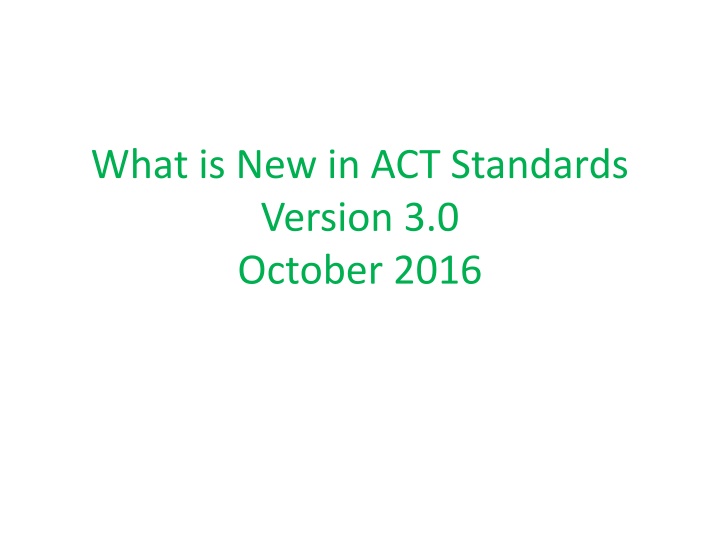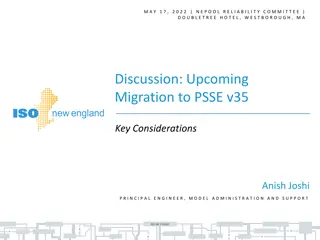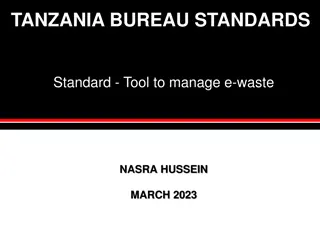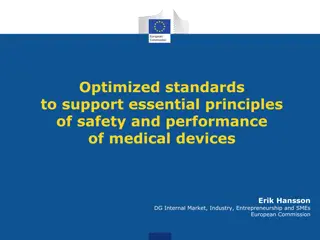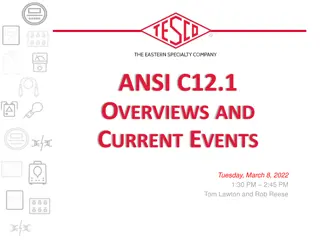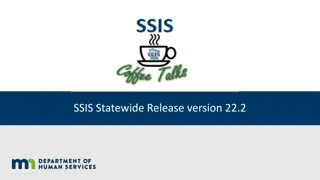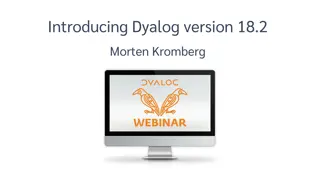Updates in ACT Standards Version 3.0 October 2016
The latest version of ACT standards in October 2016 brings forth key changes and improvements. The Ontario ACT team has been actively involved in various meetings and discussions to enhance their services. There are observations of drift and fidelity issues within the LHIN structures, indicating a need for central guidance and oversight. Funding variations among teams in Ontario and British Columbia are highlighted, along with a call for revising standards to address grey areas and uphold best practices effectively.
Download Presentation

Please find below an Image/Link to download the presentation.
The content on the website is provided AS IS for your information and personal use only. It may not be sold, licensed, or shared on other websites without obtaining consent from the author.If you encounter any issues during the download, it is possible that the publisher has removed the file from their server.
You are allowed to download the files provided on this website for personal or commercial use, subject to the condition that they are used lawfully. All files are the property of their respective owners.
The content on the website is provided AS IS for your information and personal use only. It may not be sold, licensed, or shared on other websites without obtaining consent from the author.
E N D
Presentation Transcript
What is New in ACT Standards Version 3.0 October 2016
OAA Executive John Maher, President Sarah Garside, Vice President Ruth Woodman Shelbie Drury Dave Guthrie
Process to Date... Ontario ACT Team Survey Winter 2015 Team Leaders Meeting (Barrie) March 2015 OAA Executive meetings Technical Advisory Committee meetings TLs/Psych Meeting (Toronto) June 2016 Ministry of Health discussions Sept 2016...
Assertive Community Treatment in Ontario 80 ACT teams 1 Step Down Team (Ottawa; 4 ACT teams feed into it) 8 ACT teams with Stepped Care included (CE LHIN; 1 extra staff, 25 additional clients) Many teams with some de facto flex care or stepped care capacity 3 FACT (Flexible ACT) (Toronto; Kitchener; Dual Dx Team in Ottawa)
There is some substantial drift and fidelity divergence within the new LHIN operating structures... There is a lack of central guidance and oversight for a >$104 million dollar program that produces cost avoidance benefits exceeding $400 million for Ontario.
Funding Funding per Ontario team varies: $800,000; $1,000,000; $1,200,000; $1,300,000 British Columbia teams get $1.7 million each We have developed a model ACT budget for Ontario: 1.3 million for the 21 community agency sponsored teams 1.6 million for the 59 hospital sponsored teams Rental costs vary from team to team Gas/vehicle costs can be significant over large geographic areas
The Standards need revising... to clarify grey areas to reflect current best practices to prevent erosion and fidelity drift to clarify discharge protocols and improve flow through to address stepped care service approaches to protect from intrusions by hospitals/agencies/LHINS that do not understand the importance of fidelity and client numbers for cost and service efficacy to clarify the place and role of FACT and ICM level care in Ontario.
Ontario ACT Standards There have been numerous changes in the last decade since the 2ndedition of Standards was released. The MOHLTC is no longer the direct funder of the teams. The 14 Local Health Integration Networks (LHINs) in Ontario have evolved in their oversight of ACT teams and the majority of teams are at capacity.
Ontario ACT Standards Version 3.0 Circulated to teams August 2016 We will be focusing primarily on proposed changes to the Standards today...
Appendices: Model ACT Team Budget Comprehensive Assessment Form Checklist ATR (ACT Transition Readiness Scale) Sample ACT Referral Form (CE LHIN) Sample ACT Discharge Protocol (CE LHIN) Sample ACT Team & Hospital Relationship Agreement (CE LHIN) Sample of stepped care service level responsibilities (CE LHIN)
Highlights & Changes Clients must be 18 or older, with no upper age limit.
Admission Criteria Priority is given to people with schizophrenia, other psychotic disorders (e.g., schizoaffective disorder), and bipolar disorder because these illnesses more often cause long-term psychiatric disability and because of ACT s proven effectiveness with this population.
Some other sub populations are considered appropriate if they have been referred subsequent to unsuccessful treatment from a lesser intensive community mental health service: Individuals with a primary psychotic disorder and a secondary diagnosis of personality disorder, individuals with a concurrent disorder with intractable psychotic symptoms, individuals with a dual diagnosis with a primary psychotic disorder, individuals with organic disorders with intractable psychotic symptoms
Highlights & Changes Individuals with a primary diagnosis of borderline personality disorder, substance abuse disorder, or dementia are not appropriate client groups.
Highlights & Changes ACT Teams should not accept clients with a high risk for dangerousness who are not safely manageable in the community.
Highlights & Changes There must be a clear protocol in place to manage and triage a team s waiting list.
Triage Protocol 1) readmission of your own previous ACT clients, 2) client transfers from other ACT teams, 3) forensics clients requiring ACT level community monitoring (ORB, low-moderate risk), 4) clients currently on an inpatient unit with a history of lengthy or frequent admissions who are ready for discharge (and are not being discharged prematurely because of a mistaken belief that ACT level care is comparable to custodial hospital care), and 5) clients assessed chronologically by date of referral.
Highlights & Changes An ACT team must persistently, repeatedly and assertively attempt to engage with a new client for a minimum period of six months before terminating their referral.
Highlights & Changes Special efforts should be made to engage homeless persons with mental illness. Homeless clients may be referred to ACT by homelessness outreach program staff in a given community, but where these specific outreach services do not exist, the ACT team itself should assertively attempt to engage any homeless person with suspected mental illness who comes to their attention.
Highlights & Changes Regular consideration of transition/discharge readiness is a critical activity to support appropriate flow through and foster continuing availability of spaces for new ACT clients [six month ATR (ACT Transition Readiness scale) reviews suggested].
Highlights & Changes Teams are encouraged to develop an internal stepped care service level where client need supports it, and/or where local discharge service options are limited.
Highlights & Changes It is critical to have at least three months of unsuccessful engagement before discharging an active client from service and to document each attempt at engagement, as well as each service refusal.
Highlights & Changes When a client leaves abruptly or does not cooperate in a coordinated and seamless transfer of care to another region, the ACT team should end all involvement with the client a maximum of three months after their departure.
Highlights & Changes An ACT team that is fully funded and staffed to current standards is expected to serve a catchment area of 80,000-100,000 people and have a maximum of 85 clients.
MINIMUM CAPACITY Decades of ACT experience across Ontario s expansive geography and various urban configurations has also taught us a great deal about practical limitations to service provision in some circumstances. Some teams have large geographic areas and wide population dispersal with which to contend. Others face dense urban traffic congestion.
Minimum Capacity Some have higher concentrations of forensic clients and attendant intensive monitoring responsibilities. Others operate in areas with an insufficient number of regional ACT teams and have ended up with a concentrated client group marked by extreme complexity and exponential service demands.
Highlights & Changes It is clearly recognized that some teams have had to limit their capacity to 65+ clients for justifiable reasons. Given the pressure that teams face from oversight sources and regional health authorities to constantly increase their capacity, a review mechanism is established whereby a team may request an external fidelity review in order to establish/explain a particular capacity level. The results of the review process shall be binding upon the team, sponsoring agency and LHIN.
Highlights & Changes An ACT team must be available to directly provide (or through appropriate partnerships) treatment, rehabilitation, support and crisis services seven days per week, 24 hours a day (24/7). This means regularly operating and scheduling ACT staff to work shifts, thus providing direct ACT services at least 8 hours of every day, seven days a week.
Highlights & Changes Additional daily/evening hours of ACT service are determined by clinical need. After-hours crisis service may be provided by ACT staff or through appropriate partnerships.
Examples of essential needs that may arise in the evenings are: Bedtime medication observations for non-compliant clients whose medication causes extreme drowsiness if taken earlier in the day; Any exclusively evening or bedtime medications for which a client needs medication observation or reminders; Clients who are working and for whom clinical contact is only possible in the evening; Family meetings when family members are only available in the evening; Social or recreational programs that are only available in the evening; ACT supported child visits that are only possible in the evening. Note: Some teams have successfully modified their evening practices and scheduling by incorporating pharmacy deliveries, family involvement, and flex hours for ACT staff.
Crisis Assessment and Intervention Crisis assessment and intervention must be provided 24 hours a day, seven days per week. These services include telephone and electronic media support and face-to-face contact. This is a vital part of the ACT service; it is one of the core components that make ACT an intensive treatment model.
Crisis Assessment and Intervention Many teams over the past decade have coordinated their after-hours service with their local community crisis service, and have arranged for timely reports from the crisis service on the morning after it was used by a client. This model has worked well with the implementation of crisis services throughout the province. Many teams also still conduct their own on call service directly within the team. Both models have proven to be very effective and work well...
Highlights & Changes There is no set maximum or minimum number of client contacts; staff are encouraged to do what works best to support optimal outcomes for their clients. It is up to each ACT team, using its best clinical judgement, to make this determination and it is considered inappropriate for sponsoring agencies or hospitals to provide external direction to the team on this issue.
Highlights & Changes An ACT Team needs to employ a minimum of 11 FTE multidisciplinary clinical staff persons, including the team coordinator, plus 1 FTE program assistant, and a minimum 0.8 FTE psychiatrist. (total: 12.8 FTE)
Highlights & Changes Every person on an ACT team should only work for the ACT team. For example: the team coordinator has full time responsibility with his/her team and must not manage other hospital or agency programs; the program assistant must work full time with the ACT Team and not be assigned work responsibilities outside of ACT work
Highlights & Changes It is not acceptable for funding provided to an ACT team to be used for other non-ACT services or non- ACT staff. Money not spent on that for which it was given will have to be returned.
Highlights & Changes ACT teams that have been unable to fill a mandatory position must continuously advertise the vacancy and may not hire another clinician to fill the vacancy for longer than twelve month contracts to allow for the filling of the mandatory position, should a skilled clinician become available.
Highlights & Changes All job vacancies on all ACT Teams in Ontario must be advertised on the central OAA website bulletin board. Each team is responsible for keeping listings current.
Highlights & Changes It is now optional for the team coordinator to determine whether or not they take on direct clinical care for clients. There is no longer a requirement for the team coordinator to carry a small caseload.
Highlights & Changes The Team coordinator develops and administers the ACT program budget. It is critical for the team coordinator to be aware of the team s financial resources at all times and to be a meaningful participant in all allocation decisions.
Highlights & Changes Each team must have a total of at least 3 Registered Nurses or Registered Practical Nurses (at least one of whom must be a Registered Nurse).
Highlights & Changes It is now necessary to have a peer specialist in a 1.0 FTE capacity. Each peer specialist must carry a full caseload (sponsoring agencies or hospitals may not override this requirement). Peer specialists will be required to receive role-specific training as per guidelines published from time to time by the OAA.
Comprehensive Assessment Tool The Comprehensive Assessment sub- committee of the OAA Technical Advisory Committee has developed a standardized checklist with assessment topics to guide the initial history and assessment, which when combined with the OCAN will constitute the fidelity requirements for the comprehensive assessment.
OCAN It is recommended that teams complete an initial OCAN assessment within 90 days of admission to the team. The OCAN was chosen as a provincial assessment tool with one of the important benefits being the client input component. The OCAN assessment is considered an addition to -- not a replacement for -- the comprehensive assessment. Subsequent OCAN reviews as part of treatment planning are recommended to be done annually (rather than at six month intervals) for ACT clients.
Highlights & Changes There will be a formal fidelity review of each ACT Team in Ontario at least once every 5 years. At all other times, any staff member on an ACT Team in Ontario may also request a partial or full fidelity review.
Highlights & Changes Given current wait times and service demands it is clear that an existing ACT team in Ontario must never be converted to a FACT Team. Separate standards and operational parameters are being developed for FACT Teams in Ontario.
Required Staff Team Coordinator Registered Nurse/Registered Practical Nurse Social Worker Occupational Therapist Substance Abuse Specialist Vocational Specialist Peer Specialist Other Clinical Staff Psychiatrist Program/Administrative Assistant 1FTE 3 FTE 1FTE 1FTE 1 FTE 1 FTE 1 FTE 2 FTE 0.8 FTE 1 FTE TOTAL 12.8 FTE
Two Changes... The urban/rural distinction has been eliminated. Every team should be a fully funded (1.3 -1.6 million) and staffed team. (FACT Teams will fall under another set of standards to be developed.) Specific client to staff ratios have been eliminated (now 85 clients for 12.8 FTE mandatory staff)
Team Coordinator The team coordinator ensures ACT funding is allocated appropriately, according to the Standards, and according to team needs. Team coordinators should also have responsibility to apportion resources for travel and staff education.
Psychiatrist The ACT psychiatrist is not just a consultant to the team. It is imperative that the team psychiatrist functions as a full team member. This requires attending morning meetings and the scheduled weekly treatment/recovery review meetings to offer direction and assistance to the team. The psychiatrist provides clinical services to all ACT clients; works with the team coordinator to monitor each client s clinical status and response to treatment; supervises staff delivery of services; and directs psychopharmacologic, medical services and other clinical care.
